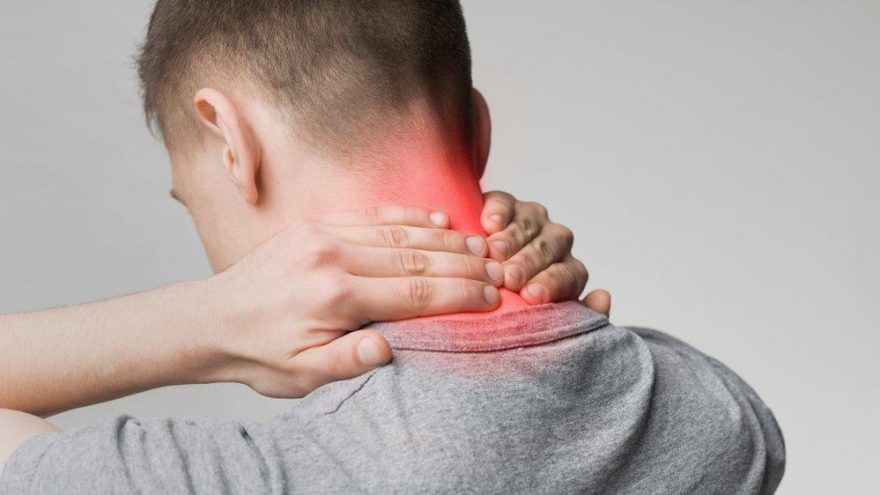- Mücahitler,52083 sokak
YASEM İŞ MERKEZİ No:42 D:173. nolu ofis 27090 Şehitkamil/Gaziantep - Mon. - Sat 9.00 - 18.00
Sunday Closed
Neck Hernia
The spine, which allows the body to stand upright, consists of 33 bones called vertebrae, through which the spinal cord passes. The vertebrae are connected to each other by a soft disc and two superficial joints. Consisting of strong connective tissue, the disc is the most important structure that connects one vertebra to another.
In the disc, there is a cartilage tissue that meets the pressure on the vertebrae as a shock absorber.
With movements such as wrong or wrong movements or lifting weights, the muscles contract and these ligaments are compressed. In addition, as we age, the center of the disc loses its water content, making the disc unable to cushion as well as before.
When the disc is damaged for these reasons, its outer layer can also rupture and the cartilage tissue inside the disc comes out of a tear in the outer layer and overflows into the space where the nerves and spinal cord are located. This also causes neck hernia. Since this overflow puts pressure on the nerves going to the arm and spinal cord, it creates various complaints.
What is Neck Hernia (Cervical Disc Herniation)?
Neck Hernia Traumas, strains, accidents, or loss of the central water content of the disc as we age can make the disc unable to cushion the disc as well as before.
As the disc continues to deteriorate, its outer layer may rupture and the center of the disc protrudes through a tear in the outer layer and protrudes into the space where the nerves and spinal cord are located, causing a herniated disc.
Our neck consists of 7 vertebrae and there are discs between our vertebrae that allow us to move. The disc, which is the most important structure connecting one vertebra to the other, consists of strong connective tissue and acts as a cushion or shock absorber between the vertebrae.
Disc and facet joints allow movement of the vertebrae, making it possible for you to bend or turn your neck and back. The disc consists of a durable outer layer called the "annulus fibrosus" and a jelly-like center called the "nucleus pulposus".
Reasons
Neck hernia occurs between the ages of 20-40, usually in people who use their body a lot. Lifting heavy loads, performing a reverse movement, and frequent pushing increases the risk of rupture of the connective tissue, that is, hernia. Traffic accidents or falling from a height are among other causes.
In addition to these, this discomfort occurs frequently in those who sit at a desk or computer for a long time, which causes posture disorders.
Prolonged use of the mobile phone, looking at the screen for a long time by bending the neck, or talking by holding the phone to the neck can also cause neck hernia.
Keeping the phone or tablet below eye level and looking at it for a long time poses a risk for herniated disc.
Although there is no genetic transmission, the risk of neck hernia in children whose parents have this disease is higher because genetic factors can be effective in the sensitivity of the disc joints.
Symptoms
The most prominent symptom of neck hernia is neck pain. But not all neck pain is caused by a hernia. Most of these are caused by muscle pain. Neck hernia occurs due to forcing and heavy lifting.
Pain due to hernia; pain in the back, shoulder blades, shoulders, back of the head and fingertips. Apart from pain, in advanced hernias, numbness, tingling and loss of strength may occur in certain areas of the arms and fingers, depending on the function of the pinched nerve.
Neck pain: It can radiate from the back of the head to the temples. It is seen as severe, persistent pain radiating to the arm.
Pain in the back, arms and shoulders
Decreased dexterity
Numbness and tingling in arms and fingers
sensory loss
Electrification
Weakness in arm and hand muscles
Weakening in reflexes
thinning of the arm
Very rarely, a herniated disc can press on the spinal cord and cause problems in the legs. Numbness in the feet, urinary and stool incontinence can be seen very rarely.
When the nerve root or a spinal cord tissue is compressed, edema may occur in that area. Since edema also increases the pressure, discomfort can enter a vicious circle.





 TÜRKÇE
TÜRKÇE ENGLISH
ENGLISH عربى
عربى 
